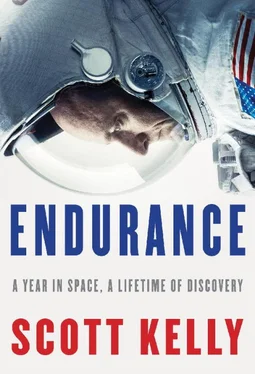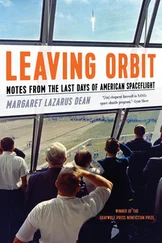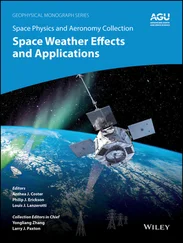Working through this together is time-consuming, but it will be worth it in the long run. I’m teaching Kjell general techniques he can use throughout his time here—for instance, the importance of putting things away in the right places. I tell Kjell he can keep the contents of a container from leaping out at him when he opens it by slowly spinning in place while holding the bag. Centrifugal force pushes the contents toward the bottom of the bag and holds them there as long as you keep spinning. Organizing the parts being inventoried is a bit trickier, but I show Kjell how to use a mesh bag to hold the objects that would otherwise be floating all over the lab and perhaps hiding themselves. Then he can move each item from the mesh bag back into the original bag as he accounts for it. For small or delicate objects, I show him how to lay out long pieces of duct tape faceup on the wall, bisected by shorter pieces facedown to hold the long one in place. Then he can stick items on the tape, keeping them from wandering off. There are patches of Velcro strategically placed on the walls, and new items often come up with Velcro dots affixed. It’s hard to express how much easier this makes life; when a certain number of new items arrive without Velcro dots, I express annoyance that probably seems out of proportion to those on the ground. But every object that arrives without Velcro on it threatens to rob me of time, patience, and ingenuity, all of which are sometimes in short supply.
—
KJELL HAS a great attitude so far and seems enthusiastic about everything he approaches, even though he looks a bit pale, with dark circles under his eyes. Every once in a while, he gets a distracted look, then excuses himself to throw up. The first few days in space can make anyone cranky, but Kjell doesn’t seem to have forgotten for one second that he is living his boyhood dream, and his positive attitude is contagious.
Kjell was born in Taiwan, to a Chinese mother and a Swedish American father. They moved to the American Midwest and then to England, where Kjell spent most of his childhood. He grew up wanting to be an astronaut, and when he was only eleven he wrote to the Air Force Academy asking for an application. When he applied as a high school senior, he was admitted and did well there. His plan had been similar to mine: become a pilot, fly jets for the military, become a test pilot, then apply to NASA and fly the space shuttle.
But after Kjell finished his degree at the academy and started flight school, a flight surgeon diagnosed him with asthma, a disqualifying condition. Kjell hadn’t experienced any symptoms, but the flight surgeon’s verdict was absolute. It looked like Kjell would never get to fly military aircraft. Forging a new life plan, he became a researcher studying the cardiovascular effects of spaceflight, then earned a medical degree. He completed residencies in emergency and aerospace medicine, then earned a master’s in public health. He went to work for NASA as a flight surgeon, looking after astronauts preparing to go to space.
Some of Kjell’s new flight surgeon colleagues were surprised or even skeptical about why he had been grounded when they heard his story. He still had not experienced any symptoms of asthma, never taken asthma medication, and was an avid runner and in great health. Some of his colleagues at the Johnson Space Center pointed out to him that while he might have been disqualified from military aviation, NASA went by its own rules. They encouraged him to apply when there was a call for new astronauts, and he did. When he was examined, no trace of asthma was found. Kjell was accepted into the astronaut corps in 2009.
I met Kjell for the first time in Star City, when he was a flight surgeon and I was training for Expedition 25/26. He is sincere and enthusiastic without ever seeming fake or calculating. He is a little on the tall side for an astronaut, with a military haircut and demeanor, but with a perpetual smile. Kjell is religious but is tolerant and respectful of other people’s beliefs; he is one of the most positive people I have ever met.
Kimiya Yui has a background similar to the one Kjell thought he was going to have. He went to Japan’s military academy and joined the Japan Air Self-Defense Force. He flew the F-15 fighter jet and then became a test pilot. Like Kjell, he joined the astronaut corps in 2009, the first class to join NASA knowing they would never get to fly on the space shuttle. Kimiya is an outstanding pilot. He is also one of the hardest-working people I’ve ever known. It’s difficult enough to learn the systems of the space station, the inner workings of the Soyuz, and a foreign language, all at once—Kimiya learned two foreign languages (Russian and English).
Kimiya is one of seven active Japanese astronauts (there are approximately forty-five active American astronauts and sixteen representing the European Space Agency). When I first got to know him in training, he seemed very formal—though I had no way to measure that, never having been assigned with a Japanese astronaut before. He would call me “Kelly-san,” a formal (though not the most formal) way to address another person in Japan. When I kept trying to get him to just call me “Scott,” he started calling me “Scott-san”; eventually, he stopped calling me anything at all. Kimiya understands that Americans value informality and equality—at least in our interactions—and he tries to meet us halfway, even if it makes him uncomfortable. Yesterday, while using the water dispenser, he saw me floating toward him out of the corner of his eye. He greeted me and moved out of the way, acting as though he was busy doing something else. But as soon as I finished getting my water and floated away, I saw him going back to the dispenser to finish filling his water bag.
Oleg Kononenko is a seasoned cosmonaut and a brilliant and rigorous engineer. He is a quiet and thoughtful person, consistently reliable. He is the same age as me and has a pair of twins the same age as Charlotte, a boy and a girl.
Kjell and Kimiya got to know each other well while training for this mission, including a wilderness course through the National Outdoor Leadership School, meant to put us into high-pressure situations, somewhat like the ones we might face in space. I wasn’t on that training course, since we weren’t originally supposed to be on the same crew, so we’ll have to get to know one another up here. In the fall, I’m going to perform two spacewalks with Kjell, and our lives will depend on us working together.
—
TODAY, Kjell, Kimiya, and I are all taking our blood, then separating it in our state-of-the-art centrifuge before storing it for eventual return to Earth.
The Russians are taking blood today too, and I go to their service module to pick up some of the samples they asked us to store in our freezer. As soon as I pass through the hatch to the Russian segment, the modules are smaller and more cluttered, the equipment is louder, and the ambient light is yellower. But this time it’s worse: the Russians are starting up their centrifuge as I arrive, and it sounds like a chainsaw. All three cosmonauts laugh when they see my reaction.
“Can you believe this?” Gennady asks, gesturing at the centrifuge, then at his ears. “Fucking blya. ”
“That thing sounds like it’s about to blow,” I say, and the Russians laugh some more. If their centrifuge were to come apart, it could take the hull of the service module with it, and we would all die.
I float back to the U.S. segment, shaking my head, my ears still ringing. I feel awful from my brief exposure to the noise—like nails on a chalkboard, but much worse.
This is just another example of the differences between our countries’ approaches to equipping the station. The Russian space agency’s goal is always to get the job done as cheaply and efficiently as possible, and I have to admit their cost-saving solutions for some problems can be impressive. The Soyuz that gets us up and down from space is a great example of this: it’s cheap, simple, and reliable. But ultimately, because the Russian hardware is unsophisticated, they are limited in the science they are able to get done. And of course at times like today, I worry about the safety of their equipment.
Читать дальше












